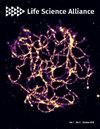Nanoscale imaging of DNA-RNA identifies transcriptional plasticity at heterochromatin.
IF 3.3
2区 生物学
Q1 BIOLOGY
引用次数: 0
Abstract
The three-dimensional structure of DNA is a biophysical determinant of transcription. The density of chromatin condensation is one determinant of transcriptional output. Chromatin condensation is generally viewed as enforcing transcriptional suppression, and therefore, transcriptional output should be inversely proportional to DNA compaction. We coupled stable isotope tracers with multi-isotope imaging mass spectrometry to quantify and image nanovolumetric relationships between DNA density and newly made RNA within individual nuclei. Proliferative cell lines and cycling cells in the murine small intestine unexpectedly demonstrated no consistent relationship between DNA density and newly made RNA, even though localized examples of this phenomenon were detected at nuclear-cytoplasmic transitions. In contrast, non-dividing hepatocytes demonstrated global reduction in newly made RNA and an inverse relationship between DNA density and transcription, driven by DNA condensates at the nuclear periphery devoid of newly made RNA. Collectively, these data support an evolving model of transcriptional plasticity that extends at least to a subset of chromatin at the extreme of condensation as expected of heterochromatin.DNA-RNA 的纳米级成像可识别异染色质的转录可塑性。
DNA 的三维结构是转录的生物物理决定因素。染色质凝聚的密度是转录输出的一个决定因素。染色质缩合通常被视为加强了转录抑制,因此,转录输出应该与 DNA 压缩成反比。我们将稳定同位素示踪剂与多同位素成像质谱联用,对单个细胞核内 DNA 密度与新产生的 RNA 之间的纳米体积关系进行量化和成像。小鼠小肠中的增殖细胞系和循环细胞出乎意料地没有显示出 DNA 密度与新产生的 RNA 之间的一致关系,尽管在核-胞质转换处检测到了这种现象的局部实例。与此相反,非分裂肝细胞显示新产生的 RNA 整体减少,DNA 密度与转录之间呈反比关系,这是由核外围没有新产生的 RNA 的 DNA 凝聚物驱动的。总之,这些数据支持转录可塑性的演化模型,该模型至少扩展到了异染色质凝集极端的染色质子集。
本文章由计算机程序翻译,如有差异,请以英文原文为准。
求助全文
约1分钟内获得全文
求助全文
来源期刊

Life Science Alliance
Agricultural and Biological Sciences-Plant Science
CiteScore
5.80
自引率
2.30%
发文量
241
审稿时长
10 weeks
期刊介绍:
Life Science Alliance is a global, open-access, editorially independent, and peer-reviewed journal launched by an alliance of EMBO Press, Rockefeller University Press, and Cold Spring Harbor Laboratory Press. Life Science Alliance is committed to rapid, fair, and transparent publication of valuable research from across all areas in the life sciences.
 求助内容:
求助内容: 应助结果提醒方式:
应助结果提醒方式:


